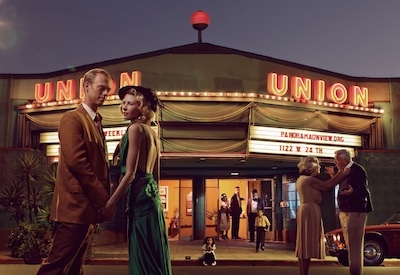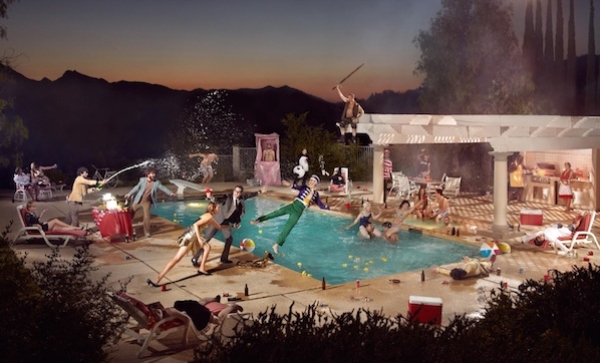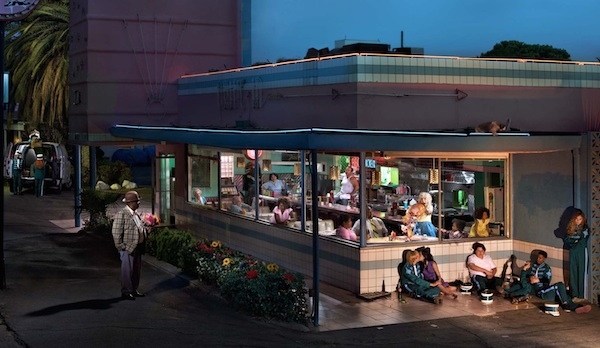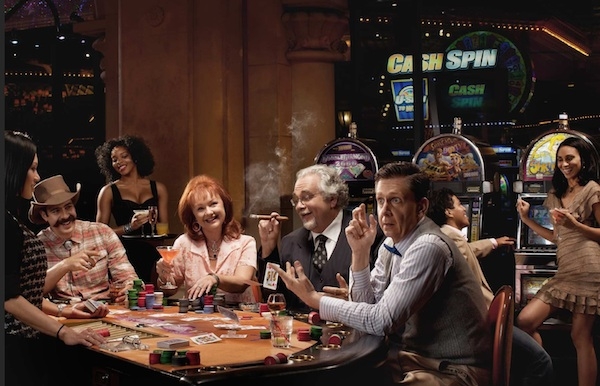Photographer Profile - Ryan Schude: "I never intended pursuing fine art as a career"

|
|
|
Schude is best known for his large-scale, elaborate images featuring groups of people engaged in various intriguing vignettes—scenes set in camp grounds, suburban homes, city diners and office spaces.
“Every image he makes is heavily staged, overflowing with outlandish scenarios and organized chaos. They can require days of preparation as he painstakingly orchestrates lighting, props and people. Nothing is left to chance. His interest in photography stems from creating that magic,” noted Wired magazine in a recent story about one of Schude’s productions—an image of an epic high-school party in which every section of the frame is filled with character and story.
The photo is the product of more than Schude’s enthusiasm for crowded composition, however. It’s also an example of the power of communal creativity.
It was shot in 2010 at Phoot Camp, an annual summer retreat in which a group of photographers get together to eat, party, and make pictures. “We just show up and do whatever we want; people are free to look into what other people are doing,” says Schude, 36. “It’s become this really strong family and community where we all stay in touch with each other throughout the year and help each other with any projects we’ve got going on.”
Each year, Schude makes a group shot of the photographers at the retreat—but in his own highly-produced style, with plenty of collaboration from everyone there. “We come up with a scenario and have everyone become a character,” Schude says. The party picture, made during a Phoot Camp retreat in LA, started as a discussion between Schude and LA-based photographer Lauren Randolph.

“We scouted the location and had everyone show up dressed as their favorite high-school stereotype,” Schude says. “Then we all figured out where everyone would be in the shot and what they would be doing. It was a day’s worth of setup, and then we shot it during the golden hour in the evening. And then we had dinner right there.”
Schude, who is also in the picture (lying beside the pool in the foreground and triggering his Canon 5D Mark II with a PocketWizard radio slave), lit the scene with a variety of gear, because, he says, “everybody brings their own stuff and we mix and match.” The final image is made up of eight separate exposures blended together in post-production. “Because the light is changing during the perfect golden hour, using too many frames would make it hard to seamlessly composite,” he says.
The end result, in every aspect, is greater than the sum of its parts.
At Phoot Camp
The party photo is part of a series that Schude calls “Tableaux Vivants,” visual fictions told in single frames, stories without beginnings or ends. “The viewer is left to make up the narrative,” Schude says.”Sometimes the pictures are visual cliches, like a high-school party, and other times they’re totally mysterious.”
The tableaux, along with work from other series, are featured in a new retrospective book, called simply Schude, due out in August. Schude is planning an opening party at The Last Bookstore in downtown LA, a literary space that already looks like a movie set. “I’m going to do a live demonstration of how I create these pictures, using people at the opening as models, and the store is the perfect backdrop for that,” he says. Schude would like to stage similar demonstrations in other cities, turning a book tour into a traveling photo project.
The “Tableaux Vivant” series began when Schude first moved to LA and began shooting editorial portraits. “It was pretty organic, actually,” he says. “I just started developing narratives for the pictures, and then one day I did a shot of a woman throwing a suitcase off the top of a building and just kept going from there.”
Schude grew up near Chicago but moved to California in 1997 to attend the San Francisco Art Institute. He spent four years in the Bay Area, then moved to San Diego, where he worked for Daily Bread, an inline-skating magazine. When the magazine folded, he went to LA and found that his portfolio of skating photos wasn’t getting him work, so he started over, assisting and working in a photo-rental business while building a new portfolio.

“The big tableaux stuff happened in part because I had access to all the equipment at the rental house,” he says. “I was coming from making these simple action shots and portraits, and all of a sudden my eyes were open to what commercial photographers were doing in LA. So I started going crazy.”
He began publishing some of his new work in the community-created photo magazine JPG, and in 2008 the publication’s editor in chief, Laura Brunow Miner, invited him, along with about 20 other regular contributors, to a get-together in China Camp State Park, north of San Francisco. That was the beginning of Phoot Camp.
“It’s funny to look back on, because we didn’t know each other then, but fast forward six years and we’re still going,” Schude says. Through the gathering, he became friends with photographers Dan Busta, Paul Octavious, Chris Butler, Daniel Lee, Chad Nicholson and Randolph, with whom he collaborates frequently.
The retreats have attracted photographers from around the world, though Miner keeps the size of the events at around 40. “It can be a big investment for people, but they get super inspired while they’re there, and they want to keep coming back,” Schude says.
The Big Tableaux
Being the unofficial group portrait photographer of Phoot Camp has allowed Schude to expand on his “Tableaux Vivant” series (with the help of some very talented assistants-slash-models). And the personal series has helped drive his commercial career.
“The need for the big tableaux work is limited, but when it comes around — when someone needs to tell a story in a single scene — it’s fun to see what pops up,” Schude says.
Last year, he and Randolph created an ad campaign for Caesar’s Casino inspired by the “Tableaux Vivant” images. “That was exciting because they were basically taking my portfolio and devising scenarios based on what I do,” Schude says.

The tableaux are obviously cinematic in nature and in visual style, so it’s not surprising to learn that Schude is also creating commercial motion work. “Before I got into photography, I was making experimental art films, and I did some music videos when I got to LA,” he says. “The mainstay has always been stills. but the tableaux idea really lends itself to motion, and the web is getting heavily into branded motion content, so I’ll keep gong in that direction.”
On the other hand, it’s his personal projects — including a portrait series featuring people and their cars, also represented in the new book — that is now defining him and his work. He’s had exhibitions of the “Tableaux Vivant” photographs in Paris and Istanbul as well as Los Angeles, and the new book presents his work in a new context, which is what a book should do.
Schude has reached that point where, like his group portraits, the whole of his career has become something bigger than its individual elements.
“I never really intended pursuing fine art — I just figured being a commercial photographer was where I was going to end up,” he says. “Now I’m being pulled further down that road.”



